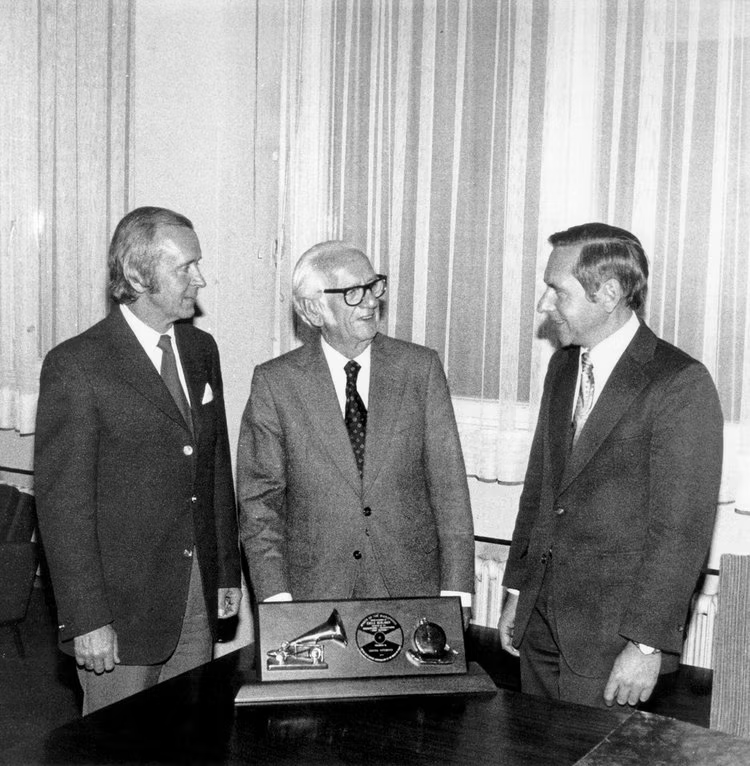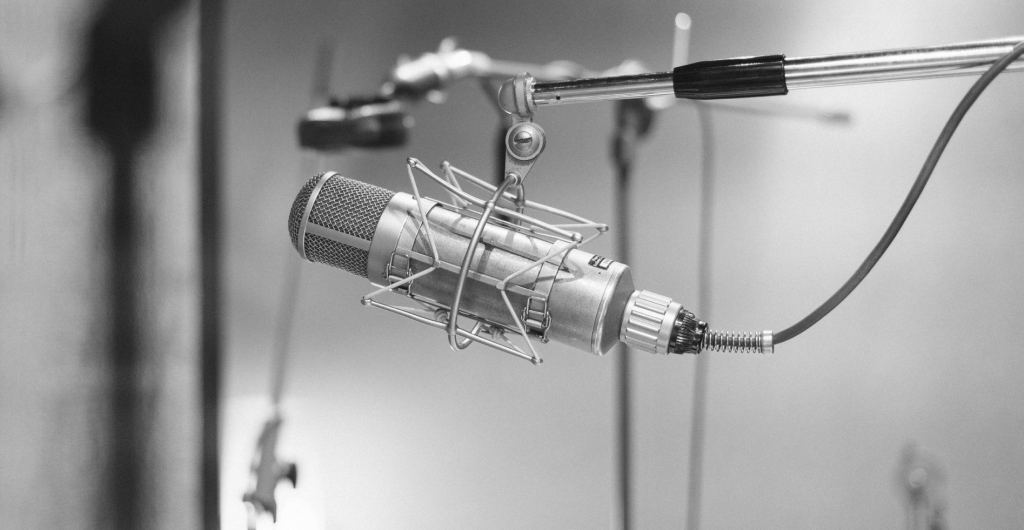Recording, Mixing and Mastering
Published on 31/07/2023

Georg Neumann (1898-1976) was a pioneering figure in the early manufacturing of microphones.
Born in Chorin, Germany, Neumann received vocational training at Mix & Genest in Berlin.
While working at AEG's research department, he collaborated with Eugen Reisz on microphone design.
Neumann eventually joined Reisz's new company, and together they developed a carbon-button-type microphone that gained popularity with German radio stations.
During the 1920s and 1930s, microphones were essential for capturing sound in various applications.
Neumann recognized the need for improved transducers and focused on developing electrostatic principles, unlike Reisz who favored a different direction.
In 1928, Neumann established his own company and introduced the CMV 3, the first mass-produced condenser microphone. The CMV 3, also known as the "Neumann Bottle," became the standard for studio and broadcast use in Germany and other European countries.
 Georg Neumann (center) receives the Emil Berliner Award
Georg Neumann (center) receives the Emil Berliner Award
In the early years, the microphone was the primary instrument for capturing dialogs and musical performances.
Today the microphone is still the transducing element of choice when attempting to record, communicate or reinforce such experiences. The microphone is the first encountered element or interface between a talker, orchestral presentation or musical presentation. It is then no wonder that input transducers (microphones) have received so much attention.
It is credited generally that E.C. Wente was the developer of the first electrostatic microphone (1917).
However, Wente’s device required a large, power-hungry power supply. For this reason it was relegated to work mainly in labs.
The prevailing microphone technology of the times continued to be the carbon microphones that were based on the telephone transmitter technology.
Although more or less adequate for telephone speech reproduction (telephone channel band is limited to 5 KHz), these microphones were not good enough for musical content.
While in the USA, attention was given to the development of dynamic devices, in Europe, more attention was being focused on improving the electrostatic concept. As mentioned, Neumann had joined forces with Reisz to develop a more satisfactory carbon capsule microphone.
Neumann examined the available carbon microphones finding them of poor quality for the purpose. In an effort to correct these deficiencies he developed a powdered carbon layer on a marble substrate inserting the assembly between two electrodes.
The result was unsatisfactory even if improved with the introduction of rubber membrane to tighten the contacts. Despite its limitations, the Reisz microphone found wide acceptance with German radio stations.
Reisz and Neumann had different opinions on many topics. Neumann was of the opinion that the future of microphone technology rested in the development of electrostatic principles.
Reisz didn’t and did not accept Neumann's interests about other recording (and non recording related) gear.
To solve this issue, in 1928, Neumann created his own company to exploit the further development of condenser microphones.
These activities resulted in the development of the CMV 3, later on defined as the Neumann Bottle.
 Neuman (Telefunken branded) CMV3 - source Reverb
Neuman (Telefunken branded) CMV3 - source Reverb
The CMV 3 was the first-ever mass-produced condenser microphone and proved to be far superior in performance when compared to all other devices.
Marketing for the Neumann microphone was assigned to the German (at the time) Company Telefunken.
From 1928 until after World War II, the device remained virtually unchanged and became the standard for studio and broadcast entities throughout Germany and many other European countries.
The Neumann family was greatly impacted by the Nazis starting from 1934 as Mrs. Neumann was Jewish.
Fortunately, Georg Neumann was largely successful in shielding his family and employees from the effects of the government’s deadly decrees.
In 1943, the Neumann factory in Berlin was destroyed by Allied bombing attacks. Subsequently, Neumann, with several of his key technical personnel and the company’s production staff, relocated to Gefell in a place that, after the war, was to become East Germany.
During the Gefell days, he developed the M7 capsule, which subsequently became the engine for the popular U47 microphone.
 U47 on duty
U47 on duty
Introduced in 1947, the U47 has probably had the greatest influence on the development of modern studio-microphone technology.
Its double diaphragm capsule allowed it to be variably switchable between a cardioid and omni pattern.
With this degree of control, the U47 quickly took over RCA ribbon microphones and the equivalent Altec/WE models.
The Neumann U48 further contributed when it was announced that the new microphone could be polarized, to produce both a cardioid and a figure-eight pattern.
As television and stereophonic recording came on the scene in the 1950s, there was more demand for increasingly stringent performance from ever-smaller microphones.
The small-format diaphragm microphone began competing with the large-format devices that had until then been prevalent.
The next significant development was the shift from vacuum-tube technology to transistors and FET circuitry and the concept of 48VDC phantom power.
Apart from microphones Neumann had several interests in other technology fields.
Some friends asked him to evaluate how to improve the recording lathe being used in the early period of audio engineering.
He made several improvements on the design and, a few months later, he came up with a variable direct drive using an electric motor acting as a direct extension of the turntable spindle.
The Neumann recording lathe (with several improvements over the years) was employed widely in disk recording studios up until the ‘80s when the vinyl was replaced by the CD.
While exploring means to stabilize the heater voltage of condenser microphones, Neumann hit on the idea of using a not-yet-available nickel-cadmium battery.
With this goal in mind, he developed a process by which such battery devices could be manufactured.
The NiCad battery suddenly became essential for the operation of so many modern electronic devices ranging from photographic flash units to hearing aids, cameras and radios was the result.
We all know Neumann for his wonderful microphones but the NiCad battery is Neumann's most significant contribution to modern technology.
Much of Neumann’s microphone development and related research efforts remained in Gefell.
Although Neumann maintained a close relationship with his colleagues in the East German plant, relationships deteriorated as the Communist government imposed increasingly stringent regulations on the exercise of free commerce.
In 1961, the Berlin Wall was built, and all interchange of information between Gefell and Berlin was silenced.
By this time, the East German government had nationalized all manufacturing companies and stripped control from previous owners.
The Communist government set about producing Neumann microphones in the Gefell plant.
Naturally, such items were not available for export to the Western world, but continued to be distributed in the Eastern Bloc nations under the brand of Microtech Gefell.
Neumann microphones were manufactured in Berlin using the name Georg Neumann GmbH.
Consequently, for about 25 years, there existed two separate and distinct producers of Neumann like microphones.
Georg Neumann passed away in 1976 not being able to see the end of the Cold War that happened in 1989.
Although Neumann’s developments are regarded widely to be in the fields of condenser microphone and disc-cutting equipment, other interesting audio equipment were manufactured by his Company.
Several custom-made consoles were delivered to numerous German and European broadcast facilities and recording studios.
Neumann was also delivering computer-controlled mixer routing systems and fully automated mixing consoles to Clients such as the Berlin Philharmonic, several broadcasting companies and the Media Center of the German Federal Defense Forces.
After the death of the founder, the Neumann Company has been sold to Sennheiser but is still alive and kicking.
This whole story is reflected in several mic models being released over the years. The sequence of the most iconic models follows.
1928 - CMV3: the 'Neumann Bottle', the first ever mass produced condenser microphone.
Diameter: 9 cm, height: 40 cm, weight: 3 kg.
Telefunken, a subsidiary of AEG, took on the marketing rights to this Neumann microphone.
1949 - U47: the first switchable pattern condenser mic. Probably the most popular Neumann microphone
1949 - MM2: the first Neumann measurement microphone
1951 - M49: based on the U47 capsule, is the first mic with continuously variable directional pattern
1953 - KM53: the Neumann first small diaphragm condenser mic
1960 - U67: universally known as the Studio Workhorse. Good for every occasion
1966 - KM84: small diaphragm condenser mic with a solid state preamp
1967 - U87: probably the most used condenser mic in the world. Solid state preamp.
1972 - U47 FET: a U47 with a FET preamp. Solid and capable in several applications
1973 - KU80: the big head by Neumann for realistic three dimensional recordings
1983 - TLM 170: the first design with no output transformer
1999 - KMS105: the first handheld condenser mic by Neumann
2003 - D01: the first digital microphone
2009 - TLM103: the first proposal for small studios
2010 - KH120AG: Neuman enters the speaker's market
2019 - NDH20: after the speakers, the headphone
2020 - V402: the dual mic preamp according Neumann
Another interesting life spent in designing and producing high end audio gear.
Georg Neumann allowed all of us to record and produce state of the art music thanks to his huge contribution to audio recording technology.
It is interesting to note that the biggest impact on our technological world is less known as it refers to the world of power batteries.
Geniuses always do it better!
The information reported here has been collected from the following sources:
Join us today and get 5% off your next order!

Empty cart